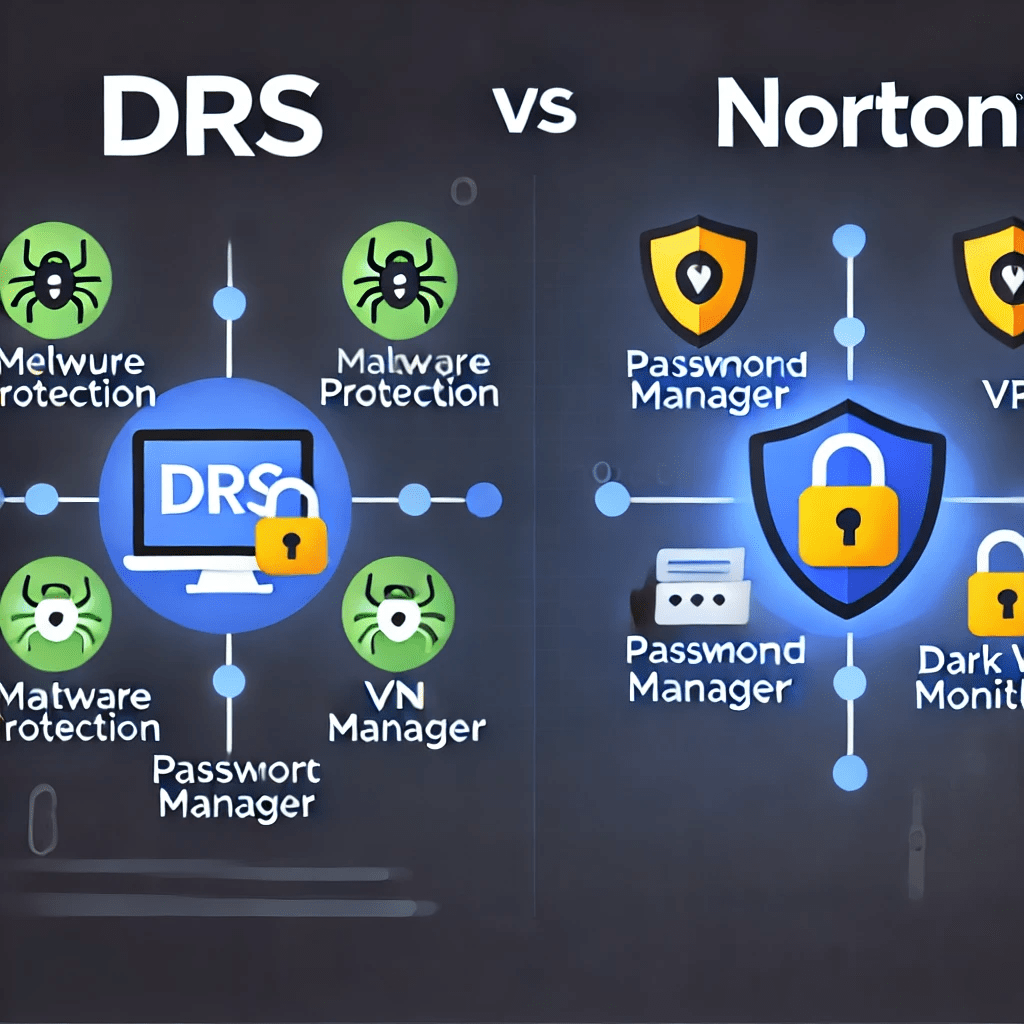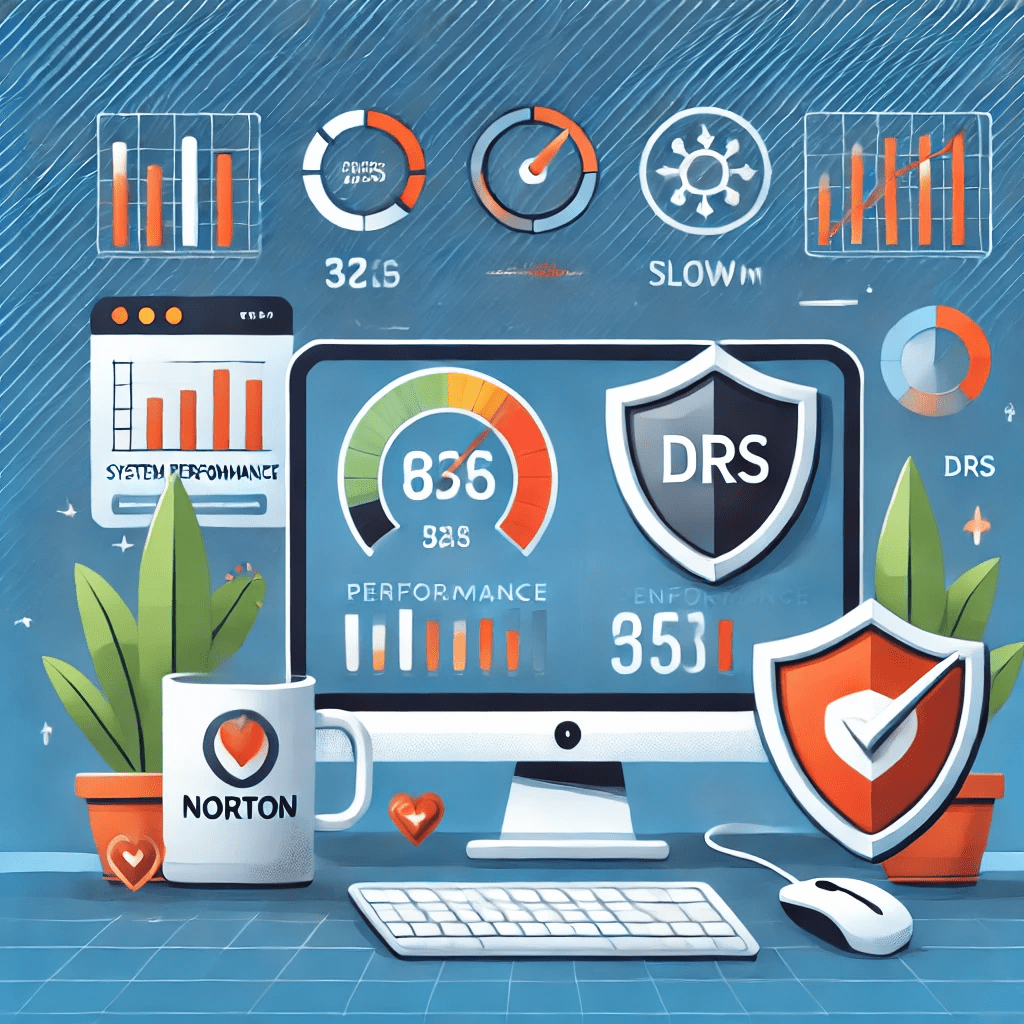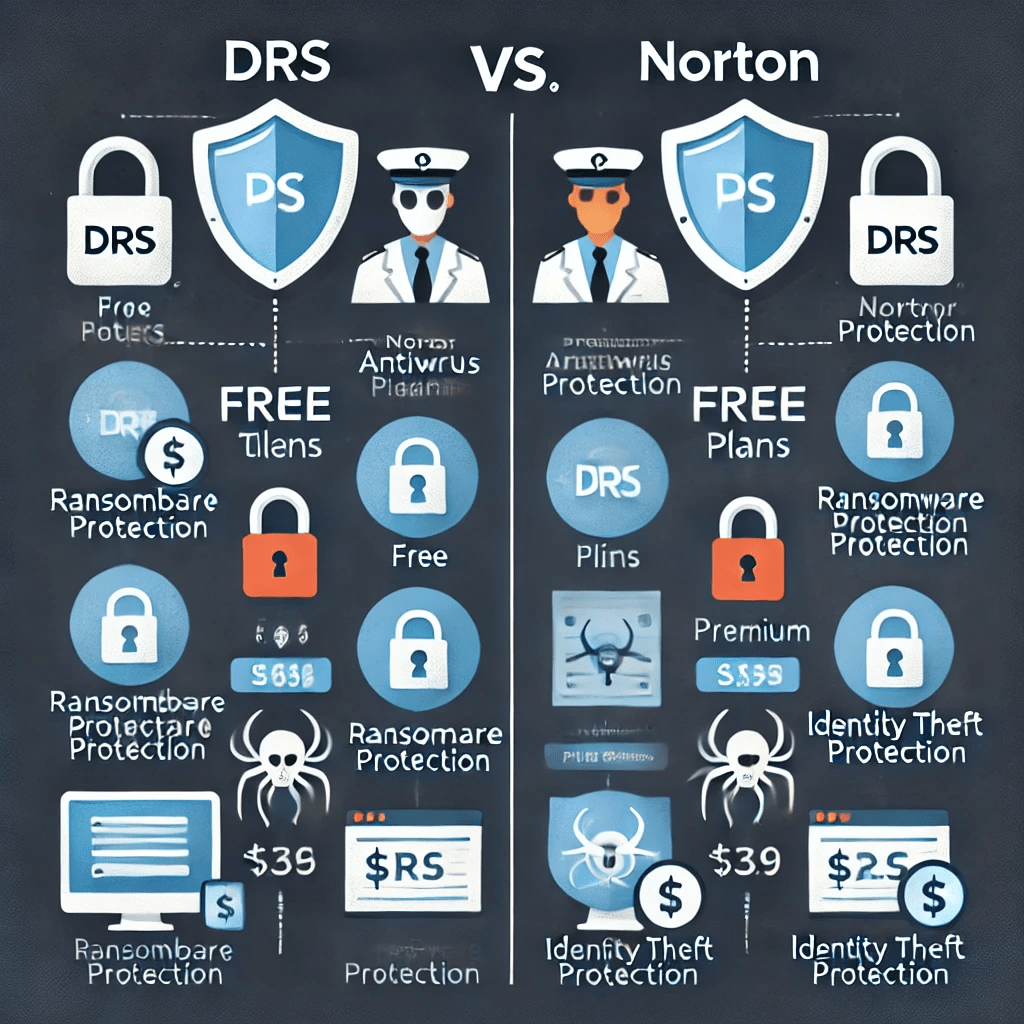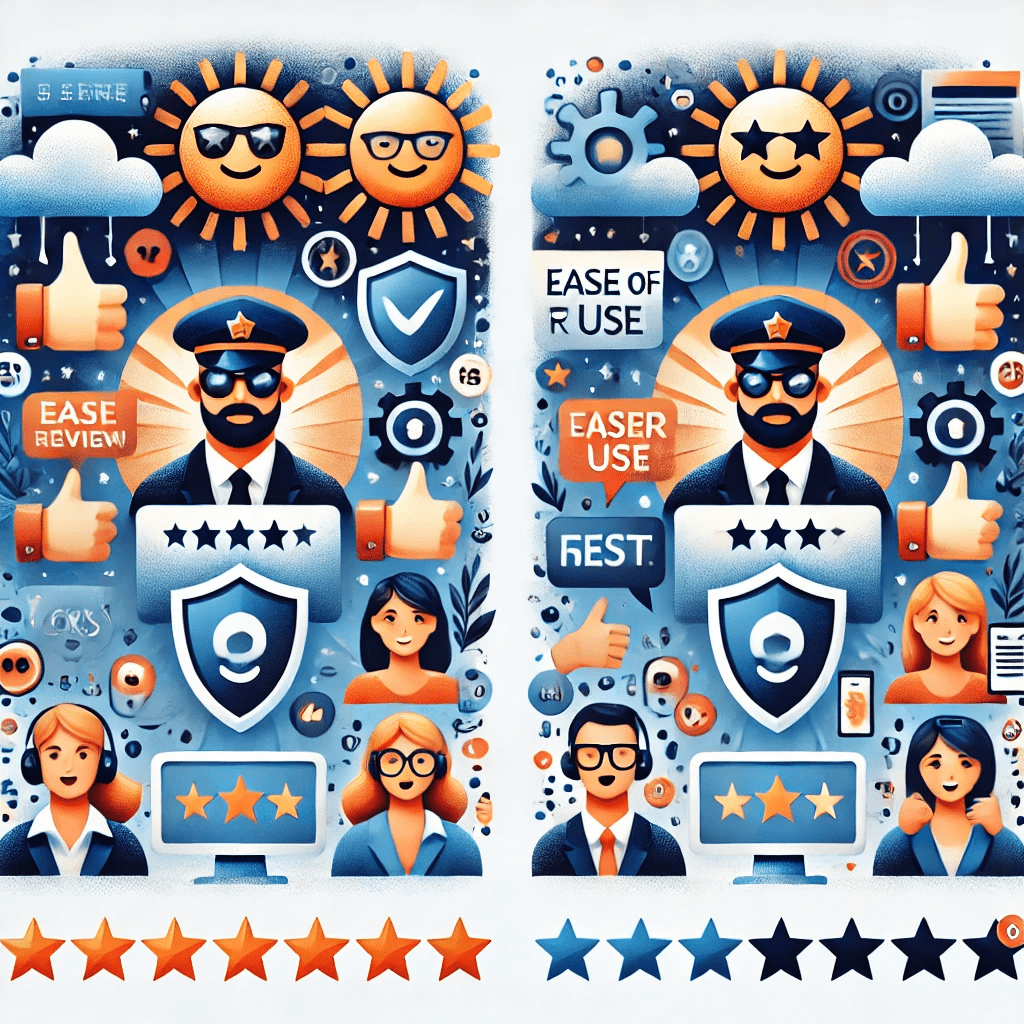DRS vs Norton: Your Best Guide in 2025
When it comes to protecting your digital life, choosing the right antivirus software is crucial. Among the top contenders in this field are DRS vs Norton. In this guide, we’ll delve into a comprehensive comparison of DRS vs Norton to help you make an informed decision. We’ll explore their features, performance, pricing, and much more. Choosing between DRS vs Norton can be challenging, but this guide is designed to provide you with all the information you need to decide which antivirus solution suits your needs best. Read on to discover everything you need to know about DRS vs Norton.
How to Choose Between DRS vs Norton
Choosing the right antivirus software involves understanding your specific needs and evaluating how each option meets those needs. Here’s a step-by-step guide on how to compare DRS vs Norton effectively:
Step 1: Assess Your Security Needs

Determine what level of protection you need. DRS vs Norton both offer robust security features, but your specific requirements might lean towards one over the other.
When assessing your security needs, it is important to consider various factors such as the types of devices you use, the nature of your online activities, and your overall digital lifestyle. For example, if you frequently access public Wi-Fi networks, you might prioritize an antivirus solution that includes a VPN for secure browsing. Alternatively, if you handle sensitive information and financial transactions online, you may require advanced features like identity theft protection and secure banking tools.
DRS vs Norton both provide a range of features to meet different security needs. Understanding your specific requirements will help you choose the antivirus software that best aligns with your digital habits and ensures comprehensive protection.
Step 2: Compare Features

- DRS: Known for its comprehensive malware protection, DRS provides advanced threat detection, real-time protection, and secure browsing.
- Norton: Offers similar features but adds additional layers like VPN services, password manager, and dark web monitoring.
Both DRS vs Norton provide essential antivirus features such as malware scanning, real-time protection, and automatic updates. However, Norton tends to include more supplementary tools in their packages. For instance, Norton’s inclusion of a VPN service can be particularly beneficial for users who frequently connect to public Wi-Fi networks and need an extra layer of security. Additionally, Norton’s dark web monitoring can alert you if your personal information appears on illegal trading sites, which is a unique feature that DRS lacks.
Moreover, Norton’s password manager helps in securely storing and managing your passwords, thus preventing unauthorized access to your accounts. DRS, while robust in its core antivirus functions, does not typically include these additional tools in its standard packages. Therefore, when comparing DRS vs Norton, it’s crucial to consider whether these supplementary tools are necessary for your security strategy.
When evaluating the features of DRS vs Norton, it is also essential to consider the usability and effectiveness of these tools. Norton’s VPN service, for example, offers a user-friendly interface and reliable performance, ensuring seamless and secure browsing experiences. The password manager is designed to simplify password management, making it easy to generate strong passwords and store them securely. Norton’s dark web monitoring continuously scans the dark web for any signs of your personal information, providing timely alerts and guidance on how to protect yourself if any data breaches are detected.
On the other hand, DRS focuses on delivering robust malware protection and advanced threat detection. Its real-time protection continuously monitors your system for any suspicious activity, blocking and removing threats before they can cause harm. DRS’s secure browsing feature provides a safe online experience by blocking malicious websites and protecting your privacy. While DRS may lack some of the supplementary tools offered by Norton, it excels in its core antivirus functions, ensuring reliable protection against a wide range of threats.
Step 3: Evaluate Performance

Both DRS vs Norton have been tested by independent labs for their performance and impact on system resources. Typically, Norton is praised for its minimal impact on system performance, while DRS is also efficient but may slightly lag in certain heavy-duty tasks.
System Impact
One significant aspect of antivirus software is its impact on system performance. Norton is well-regarded for its low impact, meaning it runs quietly in the background without significantly slowing down your computer. Independent tests, such as those from AV-Comparatives, often highlight Norton’s efficiency in this regard. Users can run multiple applications simultaneously without experiencing noticeable slowdowns.
On the other hand, DRS also performs well in terms of system impact, but some users have reported slight slowdowns during full system scans or while performing resource-intensive tasks. This minor difference might not be significant for users with high-performance computers, but for those with older systems, the performance impact of DRS vs Norton could be a deciding factor.
Detection Rates
In terms of malware detection rates, both DRS vs Norton excel. Independent testing labs like AV-Test and AV-Comparatives consistently rate both solutions highly. Norton, however, often edges out slightly in proactive threat detection, thanks to its advanced machine learning algorithms and heuristic analysis.
DRS is known for its reliable malware detection capabilities, utilizing signature-based detection and behavior analysis. It effectively identifies and neutralizes threats, ensuring your system remains secure. However, when it comes to zero-day threats, Norton’s proactive approach gives it a slight advantage in this area.
In addition to detection rates, it is important to consider the false positive rates of DRS vs Norton. False positives occur when legitimate files or programs are mistakenly identified as threats. Norton has a reputation for maintaining low false positive rates, ensuring that your system remains protected without unnecessary interruptions. DRS, while also reliable in this regard, may occasionally generate false positives, requiring manual intervention to whitelist legitimate files or programs.
Step 4: Consider Pricing and Plans

- DRS: Offers various pricing plans, including a free version with basic features and premium plans with advanced protection.
- Norton: Known for its premium pricing, Norton provides extensive features and multi-device protection, often bundled with additional services like LifeLock identity theft protection.
When comparing DRS vs Norton, pricing and available plans are essential considerations. DRS is often more affordable, offering a range of plans to suit different budgets. The free version of DRS is particularly appealing to those who need basic protection without any cost. This version includes essential features such as malware scanning, real-time protection, and secure browsing.
For users who require more comprehensive protection, DRS offers premium plans with advanced features like ransomware protection, advanced threat detection, and priority customer support. These plans are competitively priced, making DRS a cost-effective solution for those seeking robust security without breaking the bank.
Norton, on the other hand, is known for its premium pricing. However, this is justified by the extensive range of features included in its packages. Norton’s plans typically cover multiple devices, making it an excellent choice for households with various gadgets. Additionally, Norton often bundles its antivirus software with other services like LifeLock identity theft protection, providing a comprehensive security solution that extends beyond just antivirus protection.
While Norton’s pricing might be higher, the added value of these supplementary services can be worth the investment for users seeking an all-encompassing security solution. Therefore, when deciding between DRS vs Norton, it’s crucial to weigh the cost against the range of features and level of protection each solution offers.
In addition to the cost and features, it is important to consider the flexibility and scalability of the pricing plans offered by DRS vs Norton. DRS provides a range of plans that can be customized to suit different needs and budgets. Users can choose from basic plans for individual devices or opt for family plans that cover multiple devices at an affordable price. DRS also offers flexible payment options, allowing users to choose between monthly and annual subscriptions.
Norton, while generally more expensive, provides comprehensive coverage for multiple devices, making it an ideal choice for families or individuals with multiple gadgets. Norton’s plans often include additional services like LifeLock identity theft protection, which can be particularly valuable for users who prioritize comprehensive security solutions. Norton also offers flexible payment options, with discounts available for long-term subscriptions.
When evaluating the pricing and plans of DRS vs Norton, it is important to consider your specific needs and budget. While DRS offers affordable options with robust core features, Norton provides extensive coverage and additional services that can justify the higher price point for users seeking a comprehensive security solution.
Step 5: Read User Reviews and Ratings

Look at user reviews and ratings to get an idea of real-world performance and customer satisfaction for DRS vs Norton.
DRS User Reviews
DRS generally receives positive reviews from users, particularly for its ease of use and effective malware detection. Many users appreciate the straightforward installation process and intuitive interface, which makes it accessible even for those who are not tech-savvy. The free version of DRS is often praised for providing reliable protection without any cost, making it a popular choice among budget-conscious users.
However, some users have reported occasional system slowdowns during full scans, which can be a minor inconvenience. Despite this, the overall user satisfaction with DRS is high, especially given its affordability and robust core features.
Norton User Reviews
Norton, being a long-established player in the antivirus market, has garnered a substantial user base and generally positive reviews. Users frequently highlight Norton’s low impact on system performance and its comprehensive range of features. The inclusion of additional tools like VPN services, password manager, and dark web monitoring adds significant value, making Norton a favorite among users seeking an all-in-one security solution.
One common point of feedback is Norton’s higher price point. While some users feel that the premium pricing is justified by the extensive features and multi-device coverage, others find it slightly expensive compared to other solutions. Nonetheless, Norton’s strong reputation for reliable protection and minimal system impact continues to earn it high user satisfaction ratings.
In addition to user reviews, it is also beneficial to consider expert reviews and independent testing results when comparing DRS vs Norton. Expert reviews provide valuable insights into the performance, features, and overall effectiveness of antivirus software. Independent testing labs, such as AV-Test and AV-Comparatives, conduct rigorous evaluations of antivirus solutions, providing objective assessments of their detection rates, system impact, and usability.
By considering both user reviews and expert evaluations, you can gain a comprehensive understanding of the strengths and weaknesses of DRS vs Norton. This information will help you make an informed decision based on real-world experiences and independent assessments.
Step 6: Try Free Trials

Both DRS vs Norton offer free trials. Use these trials to test the software in your environment and see which one you prefer.
DRS Free Trial
DRS provides a free version with basic features, allowing users to experience its core functionalities without any cost. This version includes essential protection against malware, real-time scanning, and secure browsing. Users can upgrade to premium plans if they require advanced features like ransomware protection and priority customer support.
The free trial of DRS is an excellent opportunity to assess its performance and compatibility with your system. By using the free version, you can determine whether DRS meets your security needs and decide if upgrading to a premium plan is worthwhile.
During the free trial, it is important to thoroughly test the various features and functionalities of DRS. Conduct full system scans, perform real-time protection tests, and explore the secure browsing capabilities. Pay attention to the impact on system performance and any potential slowdowns. By thoroughly evaluating the free version, you can gain a clear understanding of DRS’s strengths and limitations.
Norton Free Trial
Norton offers a 30-day free trial for its premium plans, providing users with access to all features, including multi-device protection, VPN services, and dark web monitoring. This trial period allows users to thoroughly test Norton’s capabilities and see how it performs in various scenarios.
During the free trial, users can evaluate Norton’s impact on system performance, effectiveness in malware detection, and the added value of supplementary tools. By experiencing the full range of Norton’s features, you can make an informed decision about whether it’s the right antivirus solution for you.
In addition to testing the core features, take advantage of the supplementary tools included in Norton’s premium plans. Test the VPN service by connecting to public Wi-Fi networks and ensuring secure browsing. Explore the password manager to see how it simplifies password management and enhances security. Monitor the dark web monitoring feature to understand how it alerts you to potential data breaches and provides guidance on protecting your personal information.
By thoroughly evaluating the free trial of Norton, you can determine whether the additional features and tools justify the higher price point. Assess the overall performance, usability, and effectiveness of Norton’s antivirus software to make an informed decision.
FAQs
Is DRS better than Norton?
Determining whether DRS is better than Norton depends on your specific needs. If you require advanced features like VPN and dark web monitoring, Norton might be the better choice. For straightforward malware protection, DRS is highly reliable.
When evaluating whether DRS is better than Norton, it is important to consider the specific requirements of your digital lifestyle. Norton’s comprehensive feature set, including VPN services, password manager, and dark web monitoring, provides a holistic security solution for users who prioritize advanced tools and supplementary services. These features enhance your overall online security and privacy, making Norton a suitable choice for those who require additional layers of protection.
On the other hand, if your primary concern is reliable malware protection and you prefer a more affordable solution, DRS is a strong contender. DRS focuses on core antivirus functions, delivering effective malware detection and real-time protection without the additional frills. For users who prioritize straightforward and reliable malware protection, DRS can be a cost-effective and efficient choice.
Ultimately, the decision between DRS vs Norton depends on your specific needs and preferences. Consider the features, performance, pricing, and user reviews to determine which antivirus software aligns best with your requirements.
How do DRS vs Norton handle malware detection?
Both DRS vs Norton excel in malware detection, utilizing real-time scanning and behavioral analysis to catch threats. Independent lab tests show both perform exceptionally well, though Norton has a slight edge in proactive threat detection.
When comparing how DRS vs Norton handles malware detection, it is important to consider their detection methodologies and the technologies they employ. Norton utilizes advanced machine learning algorithms and heuristic analysis to identify and block threats in real time. This proactive approach allows Norton to detect emerging and zero-day threats before they can cause harm. Norton’s extensive database of known malware signatures, combined with its machine learning capabilities, ensures robust protection against a wide range of threats.
DRS, on the other hand, employs a combination of signature-based detection and behavior analysis to identify and neutralize malware. Signature-based detection involves comparing files and programs against a database of known malware signatures. Behavior analysis, on the other hand, monitors the behavior of files and programs to identify suspicious activities and potential threats. This multi-layered approach ensures reliable malware detection and protection.
Independent lab tests, such as those conducted by AV-Test and AV-Comparatives, consistently rate both DRS vs Norton highly in terms of malware detection. These tests evaluate the effectiveness of antivirus software in detecting and blocking various types of malware, including viruses, worms, Trojans, and ransomware. Both DRS vs Norton have demonstrated strong performance in these tests, providing users with peace of mind knowing that their systems are protected against a wide range of threats.
What are the system requirements for DRS vs Norton?
DRS vs Norton has similar system requirements, typically running smoothly on modern operating systems with at least 2 GB of RAM and 300 MB of hard disk space.
When considering the system requirements of DRS vs Norton, it is important to ensure that your computer meets the minimum specifications for optimal performance. Both DRS vs Norton are designed to run efficiently on modern operating systems, including Windows, macOS, and Linux.
For Windows users, the minimum system requirements typically include at least 2 GB of RAM and 300 MB of hard disk space. However, it is recommended to have a higher amount of RAM and available disk space for smoother performance and seamless operation. Additionally, both DRS vs Norton are compatible with the latest versions of Windows, ensuring compatibility and optimal performance.
For macOS users, the system requirements are similar, with at least 2 GB of RAM and 300 MB of hard disk space. Both DRS vs Norton are designed to run smoothly on macOS, providing reliable protection without causing significant system slowdowns. Ensure that your macOS version is up to date to ensure compatibility with the latest features and security updates.
Linux users can also benefit from the protection offered by DRS vs Norton. The system requirements for Linux are typically similar to those for Windows and macOS, with at least 2 GB of RAM and 300 MB of hard disk space. Both DRS vs Norton are compatible with popular Linux distributions, ensuring comprehensive protection for Linux users.
Can I use DRS vs Norton on multiple devices?
Yes, both DRS vs Norton offer plans that support multiple devices, including PCs, Macs, smartphones, and tablets. Norton’s multi-device plans are particularly robust, often covering up to 10 devices.
When considering the ability to use DRS vs Norton on multiple devices, it is important to evaluate the specific needs of your digital ecosystem. Norton’s multi-device plans are designed to provide comprehensive protection for all your devices, including PCs, Macs, smartphones, and tablets. This allows you to secure your entire digital life with a single subscription.
Norton’s multi-device plans often cover up to 10 devices, making it an ideal choice for households with multiple gadgets. Whether you have a combination of Windows PCs, Mac computers, iOS devices, or Android smartphones, Norton’s multi-device plans ensure that all your devices are protected. This comprehensive coverage extends to features like real-time protection, secure browsing, VPN services, and more.
DRS also offers plans that support multiple devices, ensuring that you can protect your digital life across different platforms. While DRS’s multi-device plans may not cover as many devices as Norton’s, they still provide reliable protection for a range of devices. DRS’s multi-device plans typically include features like malware scanning, real-time protection, and secure browsing, ensuring that all your devices are safeguarded against threats.
When choosing between DRS vs Norton for multi-device protection, consider the number of devices you need to protect and the specific features and services required for each device. Norton’s extensive coverage and additional tools make it a strong choice for users with multiple devices, while DRS provides reliable protection for users seeking a more affordable solution.
Does DRS vs Norton offer customer support?
Both DRS vs Norton provide customer support, but the level and availability can vary. Norton generally offers 24/7 customer support through various channels, including phone, email, and live chat. DRS also offers customer support, but the availability and response times might not be as extensive as Norton’s.
When considering the customer support provided by DRS vs Norton, it is important to evaluate the level of assistance and the channels available for obtaining support. Norton’s 24/7 customer support ensures that users can receive assistance at any time, regardless of their location or time zone. This round-the-clock support is particularly valuable for users who may encounter urgent issues or require immediate assistance.
Norton offers multiple channels for customer support, including phone, email, and live chat. Users can choose the most convenient method for obtaining support, whether it’s speaking directly with a representative, sending an email, or engaging in a live chat session. Norton’s customer support team is known for being responsive, knowledgeable, and helpful, ensuring that users receive the assistance they need on time.
DRS also provides customer support to assist users with any issues or concerns. While the availability and response times of DRS’s customer support may not be as extensive as Norton’s, DRS still offers reliable assistance through various channels. Users can typically reach out to DRS’s customer support team via email or through an online support portal. DRS’s customer support team is committed to resolving user issues and providing helpful guidance.
When evaluating the customer support of DRS vs Norton, consider your specific needs and preferences. If round-the-clock support and multiple channels for assistance are important to you, Norton’s extensive customer support offerings may be the better choice. However, if you are comfortable with email-based support and do not require immediate assistance, DRS’s customer support can still provide reliable assistance.
How do DRS vs Norton handle ransomware protection?
Ransomware protection is a critical feature in modern antivirus software. Both DRS vs Norton include ransomware protection in their premium plans. Norton’s advanced ransomware protection uses behavior analysis to detect and block ransomware threats before they can encrypt your files. DRS also offers effective ransomware protection, ensuring your data remains safe from this growing threat.
When considering how DRS vs Norton handles ransomware protection, it is important to understand the methodologies and technologies employed by each solution. Ransomware is a particularly malicious type of malware that encrypts your files and demands a ransom for their release. Effective ransomware protection is essential to safeguard your data and prevent financial loss.
Norton’s ransomware protection leverages behavior analysis to identify and block ransomware threats in real-time. By monitoring the behavior of files and programs, Norton can detect suspicious activities that indicate a ransomware attack. This proactive approach allows Norton to block ransomware threats before they can encrypt your files, ensuring that your data remains safe. Norton’s advanced machine learning algorithms and heuristic analysis further enhance its ability to detect and block emerging ransomware threats.
DRS also offers effective ransomware protection as part of its premium plans. DRS employs a combination of signature-based detection and behavior analysis to identify and neutralize ransomware threats. Signature-based detection involves comparing files and programs against a database of known ransomware signatures, while behavior analysis monitors the behavior of files and programs to identify suspicious activities. This multi-layered approach ensures reliable protection against ransomware, preventing your files from being encrypted and held hostage.
In addition to detecting and blocking ransomware threats, both DRS vs Norton offer features to help you recover from a ransomware attack. Norton’s ransomware recovery tools allow you to restore your files from backups, ensuring that you can regain access to your data even if it has been encrypted. DRS also provides backup and recovery features, allowing you to restore your files to a previous state and mitigate the impact of a ransomware attack.
When evaluating the ransomware protection capabilities of DRS vs Norton, it is important to consider the effectiveness of their detection methods, the proactive measures they employ, and the availability of recovery tools. Both solutions provide reliable protection against ransomware, but Norton’s advanced behavior analysis and recovery tools give it a slight edge in this area.
Are there any significant differences in user interface between DRS vs Norton?
Both DRS vs Norton have user-friendly interfaces, but there are some differences. Norton’s interface is sleek and modern, with a dashboard that provides easy access to all features and settings. DRS’s interface is also intuitive, but it might not be as polished as Norton’s. However, both interfaces are designed to be user-friendly and accessible, even for those who are not tech-savvy.
When considering the user interface of DRS vs Norton, it is important to evaluate the design, usability, and overall user experience. A well-designed and intuitive interface can significantly enhance the usability and effectiveness of antivirus software.
Norton’s interface is known for its sleek and modern design. The dashboard provides a clear overview of your system’s security status, with easy access to all features and settings. Norton’s interface is designed to be user-friendly, with intuitive navigation and a visually appealing layout. The various tools and features are organized logically, making it easy to find and configure the settings you need. Whether you are performing a quick scan, managing your passwords, or accessing the VPN service, Norton’s interface ensures a seamless and efficient user experience.
DRS’s interface is also designed to be user-friendly, with a straightforward and intuitive layout. The main dashboard provides a clear overview of your system’s security status, with easy access to essential features like malware scanning, real-time protection, and secure browsing. While DRS’s interface may not be as polished as Norton’s, it is still highly functional and accessible. The various settings and features are organized logically, allowing users to navigate the interface with ease.
In addition to the overall design, it is important to consider the customization options and level of control provided by the user interface. Norton’s interface offers a high degree of customization, allowing users to configure the settings according to their preferences. Users can schedule scans, set up automated tasks, and customize the behavior of various features. This level of control ensures that Norton’s antivirus software can be tailored to meet your specific needs.
DRS’s interface also provides customization options, allowing users to configure the settings and preferences according to their needs. While the level of customization may not be as extensive as Norton’s, DRS still offers sufficient control to ensure that the software operates according to your preferences. Users can schedule scans, configure real-time protection settings, and customize the behavior of various features.
When evaluating the user interface of DRS vs Norton, consider the design, usability, customization options, and overall user experience. Both solutions provide user-friendly interfaces that are accessible and easy to navigate, ensuring that you can effectively manage and configure your antivirus software.
Conclusion
In conclusion, both DRS vs Norton are excellent antivirus solutions with their strengths. Choosing between DRS vs Norton ultimately comes down to your personal needs and preferences. For those seeking additional features like VPN and identity theft protection, Norton is a strong contender. However, if you prioritize straightforward, effective malware protection, DRS is a solid choice.
For further reading on related topics, check out our articles on Best External Hard Drive for Chromebook and Hard Drive Problems and Solutions.
Additionally, you might find these external resources helpful:
- AV-Test: Independent IT-Security Institute.
- Norton Official Website: Detailed information on Norton’s features and plans.
By following this guide and considering your specific needs, you can confidently choose between DRS vs Norton and ensure your digital life is well-protected.
This comprehensive comparison of DRS vs Norton aims to equip you with all the necessary information to make an informed decision. With both options offering robust security features, your choice between DRS vs Norton will ultimately depend on your unique requirements and preferences. Whether you opt for the feature-rich Norton or the reliable and affordable DRS, you can rest assured that your digital life will be safeguarded against threats.
Choosing between DRS vs Norton can be challenging, but this guide is designed to provide you with all the information you need to decide which antivirus solution suits your needs best. Read on to discover everything you need to know about DRS vs Norton.
When it comes to protecting your digital life, choosing the right antivirus software is crucial. Among the top contenders in this field are DRS vs Norton. In this guide, we’ll delve into a comprehensive comparison of DRS vs Norton to help you make an informed decision. We’ll explore their features, performance, pricing, and much more.
Choosing between DRS vs Norton can be challenging, but this guide is designed to provide you with all the information you need to decide which antivirus solution suits your needs best. Read on to discover everything you need to know about DRS vs Norton.
When it comes to protecting your digital life, choosing the right antivirus software is crucial. Among the top contenders in this field are DRS vs Norton. In this guide, we’ll delve into a comprehensive comparison of DRS vs Norton to help you make an informed decision. We’ll explore their features, performance, pricing, and much more.
Choosing between DRS vs Norton can be challenging, but this guide is designed to provide you with all the information you need to decide which antivirus solution suits your needs best. Read on to discover everything you need to know about DRS vs Norton.
When it comes to protecting your digital life, choosing the right antivirus software is crucial. Among the top contenders in this field are DRS vs Norton. In this guide, we’ll delve into a comprehensive comparison of DRS vs Norton to help you make an informed decision. We’ll explore their features, performance, pricing, and much more.
Choosing between DRS vs Norton can be challenging, but this guide is designed to provide you with all the information you need to decide which antivirus solution suits your needs best. Read on to discover everything you need to know about DRS vs Norton.
